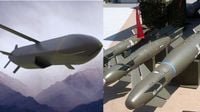In a dramatic escalation of tensions in the Jammu region, sirens echoed through the air on May 8, 2025, as Pakistan launched aerial attacks using loitering munitions. This aggressive maneuver came in response to India's recent military operation, dubbed Operation Sindoor, which involved the use of advanced loitering munitions against targets in Pakistan-administered Kashmir.
According to reports from ABP News, the Indian Air Defence forces swiftly retaliated, intercepting the aerial threats with their own artillery. Loud explosions resonated throughout Jammu, underscoring the severity of the situation. Eyewitness accounts confirmed that sirens blared in areas such as Akhnoor, heightening fears among residents.
In the wake of these military actions, internet services were suspended across the Union Territory, a move that typically signals heightened security measures during conflict. The suspension of internet connectivity is often employed to prevent the spread of information that could exacerbate tensions or lead to unrest.
The use of loitering munitions by India marks a significant evolution in its military strategy. These drones, often referred to as "kamikaze drones," possess the ability to not only scout potential targets but also decide autonomously whether to engage based on the presence of high-value targets. This capability minimizes collateral damage and enhances operational effectiveness.
India's development of such technology, particularly the Nagastra-1 drone, has been a focal point of its defense strategy. The Nagastra-1, which carries a payload of 1 kg and is equipped with precise GPS targeting, is designed to strike within 2 meters of its intended target. An initial order for 120 units has already been delivered to the Indian Army, with a total projected order of 420 units.
Operation Sindoor, carried out on the same day as the Pakistani attacks, showcased the effectiveness of these loitering munitions. The Indian Armed Forces utilized them to target terrorist infrastructure across the border, a move that has been framed as essential for national security. Experts suggest that the successful deployment of loitering munitions not only demonstrates India's commitment to self-reliance in defense technology but also reflects a broader trend in modern warfare.
Historically, the operational success of loitering munitions has been observed in various global conflicts, including the ongoing Israel-Hamas conflict and the Russia-Ukraine war. These examples underline the strategic importance of such technology in contemporary military engagements.
While the situation remains fluid, the actions taken by both India and Pakistan on May 8 have raised alarms about the potential for further escalation. The international community is closely monitoring developments, as the region has long been a flashpoint for conflict.
As tensions simmer, the implications of these military maneuvers extend beyond immediate security concerns. Analysts warn that continued hostilities could destabilize the region further, potentially drawing in other nations and complicating diplomatic efforts.
In summary, the events of May 8, 2025, represent a critical moment in the ongoing conflict between India and Pakistan. With both nations demonstrating their military capabilities, the potential for escalation looms large, raising questions about the future of peace and stability in the region.





